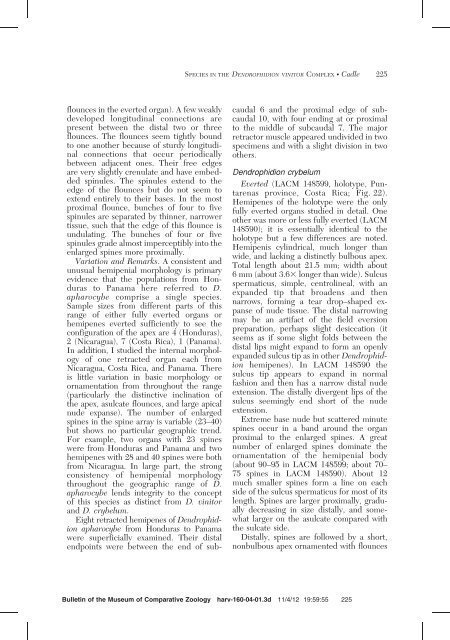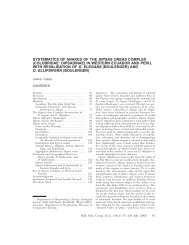cryptic species within the dendrophidion vinitor complex in middle ...
cryptic species within the dendrophidion vinitor complex in middle ...
cryptic species within the dendrophidion vinitor complex in middle ...
You also want an ePaper? Increase the reach of your titles
YUMPU automatically turns print PDFs into web optimized ePapers that Google loves.
SPECIES IN THE DENDROPHIDION VINITOR COMPLEX N Cadle 225<br />
flounces <strong>in</strong> <strong>the</strong> everted organ). A few weakly<br />
developed longitud<strong>in</strong>al connections are<br />
present between <strong>the</strong> distal two or three<br />
flounces. The flounces seem tightly bound<br />
to one ano<strong>the</strong>r because of sturdy longitud<strong>in</strong>al<br />
connections that occur periodically<br />
between adjacent ones. Their free edges<br />
are very slightly crenulate and have embedded<br />
sp<strong>in</strong>ules. The sp<strong>in</strong>ules extend to <strong>the</strong><br />
edge of <strong>the</strong> flounces but do not seem to<br />
extend entirely to <strong>the</strong>ir bases. In <strong>the</strong> most<br />
proximal flounce, bunches of four to five<br />
sp<strong>in</strong>ules are separated by th<strong>in</strong>ner, narrower<br />
tissue, such that <strong>the</strong> edge of this flounce is<br />
undulat<strong>in</strong>g. The bunches of four or five<br />
sp<strong>in</strong>ules grade almost imperceptibly <strong>in</strong>to <strong>the</strong><br />
enlarged sp<strong>in</strong>es more proximally.<br />
Variation and Remarks. A consistent and<br />
unusual hemipenial morphology is primary<br />
evidence that <strong>the</strong> populations from Honduras<br />
to Panama here referred to D.<br />
apharocybe comprise a s<strong>in</strong>gle <strong>species</strong>.<br />
Sample sizes from different parts of this<br />
range of ei<strong>the</strong>r fully everted organs or<br />
hemipenes everted sufficiently to see <strong>the</strong><br />
configuration of <strong>the</strong> apex are 4 (Honduras),<br />
2 (Nicaragua), 7 (Costa Rica), 1 (Panama).<br />
In addition, I studied <strong>the</strong> <strong>in</strong>ternal morphology<br />
of one retracted organ each from<br />
Nicaragua, Costa Rica, and Panama. There<br />
is little variation <strong>in</strong> basic morphology or<br />
ornamentation from throughout <strong>the</strong> range<br />
(particularly <strong>the</strong> dist<strong>in</strong>ctive <strong>in</strong>cl<strong>in</strong>ation of<br />
<strong>the</strong> apex, asulcate flounces, and large apical<br />
nude expanse). The number of enlarged<br />
sp<strong>in</strong>es <strong>in</strong> <strong>the</strong> sp<strong>in</strong>e array is variable (23–40)<br />
but shows no particular geographic trend.<br />
For example, two organs with 23 sp<strong>in</strong>es<br />
were from Honduras and Panama and two<br />
hemipenes with 28 and 40 sp<strong>in</strong>es were both<br />
from Nicaragua. In large part, <strong>the</strong> strong<br />
consistency of hemipenial morphology<br />
throughout <strong>the</strong> geographic range of D.<br />
apharocybe lends <strong>in</strong>tegrity to <strong>the</strong> concept<br />
of this <strong>species</strong> as dist<strong>in</strong>ct from D. <strong>v<strong>in</strong>itor</strong><br />
and D. crybelum.<br />
Eight retracted hemipenes of Dendrophidion<br />
apharocybe from Honduras to Panama<br />
were superficially exam<strong>in</strong>ed. Their distal<br />
endpo<strong>in</strong>ts were between <strong>the</strong> end of subcaudal<br />
6 and <strong>the</strong> proximal edge of subcaudal<br />
10, with four end<strong>in</strong>g at or proximal<br />
to <strong>the</strong> <strong>middle</strong> of subcaudal 7. The major<br />
retractor muscle appeared undivided <strong>in</strong> two<br />
specimens and with a slight division <strong>in</strong> two<br />
o<strong>the</strong>rs.<br />
Dendrophidion crybelum<br />
Everted (LACM 148599, holotype, Puntarenas<br />
prov<strong>in</strong>ce, Costa Rica; Fig. 22).<br />
Hemipenes of <strong>the</strong> holotype were <strong>the</strong> only<br />
fully everted organs studied <strong>in</strong> detail. One<br />
o<strong>the</strong>r was more or less fully everted (LACM<br />
148590); it is essentially identical to <strong>the</strong><br />
holotype but a few differences are noted.<br />
Hemipenis cyl<strong>in</strong>drical, much longer than<br />
wide, and lack<strong>in</strong>g a dist<strong>in</strong>ctly bulbous apex.<br />
Total length about 21.5 mm; width about<br />
6 mm (about 3.63 longer than wide). Sulcus<br />
spermaticus, simple, centrol<strong>in</strong>eal, with an<br />
expanded tip that broadens and <strong>the</strong>n<br />
narrows, form<strong>in</strong>g a tear drop–shaped expanse<br />
of nude tissue. The distal narrow<strong>in</strong>g<br />
may be an artifact of <strong>the</strong> field eversion<br />
preparation, perhaps slight desiccation (it<br />
seems as if some slight folds between <strong>the</strong><br />
distal lips might expand to form an openly<br />
expanded sulcus tip as <strong>in</strong> o<strong>the</strong>r Dendrophidion<br />
hemipenes). In LACM 148590 <strong>the</strong><br />
sulcus tip appears to expand <strong>in</strong> normal<br />
fashion and <strong>the</strong>n has a narrow distal nude<br />
extension. The distally divergent lips of <strong>the</strong><br />
sulcus seem<strong>in</strong>gly end short of <strong>the</strong> nude<br />
extension.<br />
Extreme base nude but scattered m<strong>in</strong>ute<br />
sp<strong>in</strong>es occur <strong>in</strong> a band around <strong>the</strong> organ<br />
proximal to <strong>the</strong> enlarged sp<strong>in</strong>es. A great<br />
number of enlarged sp<strong>in</strong>es dom<strong>in</strong>ate <strong>the</strong><br />
ornamentation of <strong>the</strong> hemipenial body<br />
(about 90–95 <strong>in</strong> LACM 148599; about 70–<br />
75 sp<strong>in</strong>es <strong>in</strong> LACM 148590). About 12<br />
much smaller sp<strong>in</strong>es form a l<strong>in</strong>e on each<br />
side of <strong>the</strong> sulcus spermaticus for most of its<br />
length. Sp<strong>in</strong>es are larger proximally, gradually<br />
decreas<strong>in</strong>g <strong>in</strong> size distally, and somewhat<br />
larger on <strong>the</strong> asulcate compared with<br />
<strong>the</strong> sulcate side.<br />
Distally, sp<strong>in</strong>es are followed by a short,<br />
nonbulbous apex ornamented with flounces<br />
Bullet<strong>in</strong> of <strong>the</strong> Museum of Comparative Zoology harv-160-04-01.3d 11/4/12 19:59:55 225







